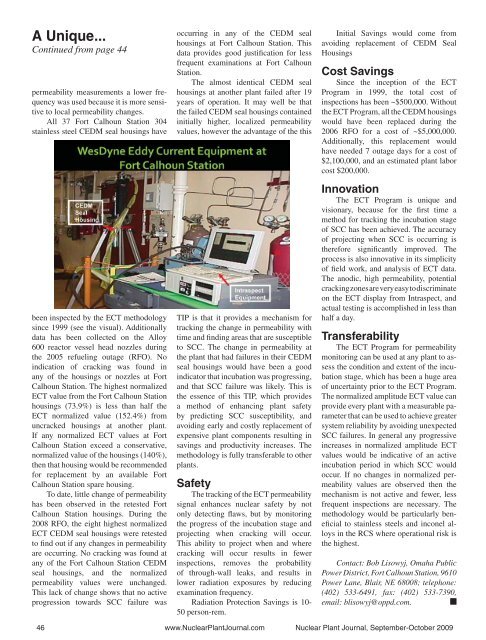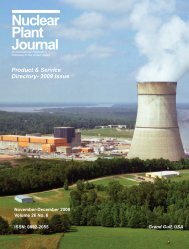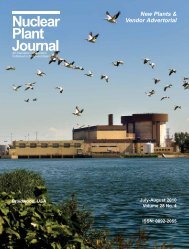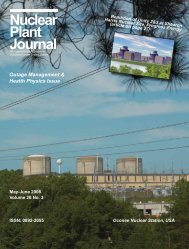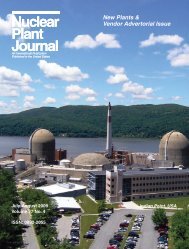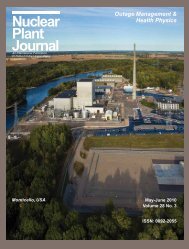Nuclear Plant Journal Nuclear Plant Journal - Digital Versions
Nuclear Plant Journal Nuclear Plant Journal - Digital Versions
Nuclear Plant Journal Nuclear Plant Journal - Digital Versions
- No tags were found...
You also want an ePaper? Increase the reach of your titles
YUMPU automatically turns print PDFs into web optimized ePapers that Google loves.
A Unique...Continued from page 44permeability measurements a lower frequencywas used because it is more sensitiveto local permeability changes.All 37 Fort Calhoun Station 304stainless steel CEDM seal housings havebeen inspected by the ECT methodologysince 1999 (see the visual). Additionallydata has been collected on the Alloy600 reactor vessel head nozzles duringthe 2005 refueling outage (RFO). Noindication of cracking was found inany of the housings or nozzles at FortCalhoun Station. The highest normalizedECT value from the Fort Calhoun Stationhousings (73.9%) is less than half theECT normalized value (152.4%) fromuncracked housings at another plant.If any normalized ECT values at FortCalhoun Station exceed a conservative,normalized value of the housings (140%),then that housing would be recommendedfor replacement by an available FortCalhoun Station spare housing.To date, little change of permeabilityhas been observed in the retested FortCalhoun Station housings. During the2008 RFO, the eight highest normalizedECT CEDM seal housings were retestedto find out if any changes in permeabilityare occurring. No cracking was found atany of the Fort Calhoun Station CEDMseal housings, and the normalizedpermeability values were unchanged.This lack of change shows that no activeprogression towards SCC failure wasoccurring in any of the CEDM sealhousings at Fort Calhoun Station. Thisdata provides good justification for lessfrequent examinations at Fort CalhounStation.The almost identical CEDM sealhousings at another plant failed after 19years of operation. It may well be thatthe failed CEDM seal housings containedinitially higher, localized permeabilityvalues, however the advantage of the thisTIP is that it provides a mechanism fortracking the change in permeability withtime and finding areas that are susceptibleto SCC. The change in permeability atthe plant that had failures in their CEDMseal housings would have been a goodindicator that incubation was progressing,and that SCC failure was likely. This isthe essence of this TIP, which providesa method of enhancing plant safetyby predicting SCC susceptibility, andavoiding early and costly replacement ofexpensive plant components resulting insavings and productivity increases. Themethodology is fully transferable to otherplants.SafetyThe tracking of the ECT permeabilitysignal enhances nuclear safety by notonly detecting flaws, but by monitoringthe progress of the incubation stage andprojecting when cracking will occur.This ability to project when and wherecracking will occur results in fewerinspections, removes the probabilityof through-wall leaks, and results inlower radiation exposures by reducingexamination frequency.Radiation Protection Savings is 10-50 person-rem.Initial Savings would come fromavoiding replacement of CEDM SealHousingsCost SavingsSince the inception of the ECTProgram in 1999, the total cost ofinspections has been ~$500,000. Withoutthe ECT Program, all the CEDM housingswould have been replaced during the2006 RFO for a cost of ~$5,000,000.Additionally, this replacement wouldhave needed 7 outage days for a cost of$2,100,000, and an estimated plant laborcost $200,000.InnovationThe ECT Program is unique andvisionary, because for the first time amethod for tracking the incubation stageof SCC has been achieved. The accuracyof projecting when SCC is occurring istherefore significantly improved. Theprocess is also innovative in its simplicityof field work, and analysis of ECT data.The anodic, high permeability, potentialcracking zones are very easy to discriminateon the ECT display from Intraspect, andactual testing is accomplished in less thanhalf a day.TransferabilityThe ECT Program for permeabilitymonitoring can be used at any plant to assessthe condition and extent of the incubationstage, which has been a huge areaof uncertainty prior to the ECT Program.The normalized amplitude ECT value canprovide every plant with a measurable parameterthat can be used to achieve greatersystem reliability by avoiding unexpectedSCC failures. In general any progressiveincreases in normalized amplitude ECTvalues would be indicative of an activeincubation period in which SCC wouldoccur. If no changes in normalized permeabilityvalues are observed then themechanism is not active and fewer, lessfrequent inspections are necessary. Themethodology would be particularly beneficialto stainless steels and inconel alloysin the RCS where operational risk isthe highest.Contact: Bob Lisowyj, Omaha PublicPower District, Fort Calhoun Station, 9610Power Lane, Blair, NE 68008; telephone:(402) 533-6491, fax: (402) 533-7390,email: blisowyj@oppd.com. 46 www.<strong>Nuclear</strong><strong>Plant</strong><strong>Journal</strong>.com <strong>Nuclear</strong> <strong>Plant</strong> <strong>Journal</strong>, September-October 2009


